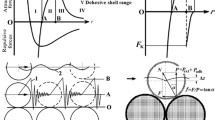Abstract
An interfacial potential barrier theory to calculate friction and wear is proposed by considering the micro interaction of frictional surfaces. The theory suggests that the performance of friction and wear depends on the magnitude and distribution of the interfacial potential barrier on contact surfaces. The calculation methods of the interfacial potential barrier and standard interfacial potential barrier are then studied and the formulas to calculate the friction force, friction coefficient, and quantity of adhesion wear are derived based on the theory. With its independence and stability, the standard interfacial potential barrier can be used as an index to describe the frictional performance of materials. The calculation results of the friction force with some existing experimental data are consistent with the experimental results performed with an ultra high vacuum atomic-force microscope, which proves that the theory and method are feasible.
Similar content being viewed by others
References
Krim J. Surface science and the atomic-scale origins of friction: what once was old is new again. Surface Science, 2002, 500(3): 741–758
Wen Shizhu, Huang Ping. The Theory of Tribology. 2nd ed. Beijing: Tsinghua University Press, 2002 (in Chinese)
КрагеЛьСКлЙ. Calculating Theory of Friction and Wear. WangYiling, et al. Translate. Beijing: Mechanical Industry Press, 1982 (in Chinese)
Bowden F P, Tabor D. The Friction and Lubrication of Solids. Oxford: Oxford University Press, 1954
Gnecco E, Bennewitz R, Gyalog T, et al. Friction experiments on the nanometre scale. Journal of Physics: Condensed Matter, 2001, 13(31): R619–642
Urbakh M, Klafter J, Gourdon D, et al. The nonlinear nature of friction. Nature, 2004, 430(6999): 525–528
Yoshitsugu K. Accuracy in tribology. In: Proceedings of the International Tribology Conference, Nagasaki, Japan, 2000
Luo Jianbin, He Yu, Wen Shizhu, et al. Challenges to tribology arisen from the development of micro-and nanomanufacturing technology. Tribology, 2005, 25(3): 283–288 (in Chinese)
Czichos H. Tribology—A Systems Approach to the Science and Technology of Friction, Lubrication and Wear. Holland: Elsevier, 1979
Ludema K C. Mechanism-based modeling of friction and wear. Wear, 1996, 200(1–2): 1–7
Xie Youbai. Three axioms in tribology. Tribology, 2001, 21(3): 161–166 (in Chinese)
Johnson K L. Contact Mechanics. London: Cambridge University Press, 1985
Yang J, Komvopoulos K. A mechanics approach to static friction of elastic-plastic fractal surfaces. ASME Journal of Tribology, 2005, 127(2): 315–324
Li Rusheng. Non-Equilibrium Thermodynamics and Dissipation Structure. Beijing: Tsinghua University Press, 1986 (in Chinese)
Tomlinson G A. A molecular theory of friction. PhilMag Series, 1929, 7: 905–939
Xu Zhongming, Huang Ping. Composite oscillator model for the energy dissipation mechanism of friction. Acta Phys Sin, 2006, 55(5): 2427–2432 (in Chinese)
Smith J R, Perry T, Banerjea A, et al. Equivalent-crystal theory of metal and semiconductor surface and defects. Physical Review B, 1991, 44(12): 6444–6465
Zhang Kecong. Modern Crystallography Theory. Beijing: Science Press, 1987 (in Chinese)
Feng Duang. Metal Physics. Beijing: Science Press, 1987 (in Chinese)
James H R, Smith J R, Ferrante J. Universal features of bonding in metals. Physical Review B, 1983, 28(4): 1835–1845
Vitos L, Ruban A V, Skriver H L, et al. The surface energy of metals. Surface Science, 1998, 411(1–2): 186–202
Xu Zhongming. Study on Frictional Characteristic and Calculation Based on Potential Barrier Method of Contact Surface. Guangzhou: South China University of Technology, 2006 (in Chinese)
Bennewitz R, Gyalog T, Guggisberg M, et al. Atomic-scale stick-slip processes on Cu (111). Physical Review B, 1999, 60(16): R11301–11304
SФrensen MR, Jacobsen KW, Stoltze P. Simulations of atomicscale sliding friction. Physical Review B, 1996, 53: 2101–2113
Fischer TE, Mullins WM. Chemical aspects of ceramic tribology. The Journal of Physical Chemistry, 1992, 96(14): 5690–5701
Author information
Authors and Affiliations
Corresponding author
Additional information
__________
Translated from Tribology, 2007, 27(1): 54–59 [译自: 摩擦学学报]
Rights and permissions
About this article
Cite this article
Xu, Z., Ding, L. & Huang, P. Interfacial potential barrier theory of friction and wear. Front. Mech. Eng. China 3, 276–282 (2008). https://doi.org/10.1007/s11465-008-0043-0
Published:
Issue Date:
DOI: https://doi.org/10.1007/s11465-008-0043-0




